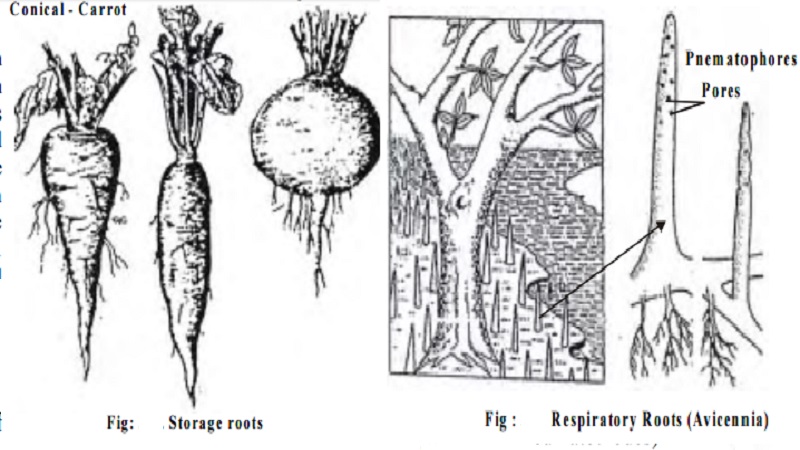Chapter: 11th 12th standard bio Biotany Plant Tree higher secondary school
Root Modifications for Taproot, adventitious roots

Root Modifications
Besides primary functions like absorption and anchorage some roots also perform certain additional functions in order to meet some specific needs. These roots are modified in their structure to perform these special functions.
Modification of Taproot
1. Storage Roots:
In some plants the tap root or the primary root becomes thick and fleshy due to the storage of food materials. These are called root tubers or tuberous roots. They are classified in to three types based on their shape.
Conical : In this type the root tuber is conical in its shape i.e. it is broad at the base and tapers gradually towards the apex. eg.Carrot
Fusiform : The root is swollen in the middle and tapers towards the base and the apex. eg. Radish
Napiform: The root tuber has a top-like appearance. It is very broad at the base and suddenly tapers like a tail at the apex eg. Beet root.
2. Respiratory or breathing roots

In plants which grow in marshy places like in Avicennia, the soil becomes saturated with water and aeration is very poor. In these cases erect roots arise from the ordinary roots that lie buried in the saline water. These erect roots are called pneumatophores. They have a large number of breathing pores or (pheumatothodes) for the exchange of gases.
Modifications of adventitious roots
1. Storage Roots:
In some plants the adventitious roots store food and become fleshy and swollen. It may assume the following shapes.
Tuberous Roots: These are without any definite shape. Eg.Sweet Potato
Fasciculated Root: In this type the tuberous roots occur in clusters at the base of the stem eg. Asparagus, Dahlia.
Nodulose Roots: In this type the roots become swollen near the tips. Eg.Mango ginger and turmeric
2. Roots modified for additional support
Stilt roots: These adventitious roots arise from the first few nodes of the stem. These penetrate obliquely down in to the soil and give support to the plant. eg. Maize, sugarcane and pandanus.
B . Prop roots: These roots give mechanical support to the aerial branches as in banyan tree.
These lateral branches grow vertically downwards into the soil. Gradually, the roots become thick and stout and act as pillars.
3. Roots modified for other vital functions

a) Epiphytic roots: These are adventitious roots found in some orchids that grow as epiphytes upon the branches of other trees. These epiphytes develop special kinds of aerial roots which hang freely in the air. These aerial roots possess a special sponge like tissue called velamen. Velamen helps in absorbing the atmospheric moisture and stores them since these plants do not have direct contact with the soil.
b) Photosynthetic or assimilatory roots: In some plants the adventitious roots become green and carry on photosynthesis. These roots are called photosynthetic or assimilatory roots: In Tinospora roots arise as green hanging threads from the nodes of the stem during rainy season. They assimilate co2 in the presence of sunlight.
c) Parasitic roots or haustoria : These roots are found in non-green parasitic plants. Parasitic plants are those plants which cannot make their own food and they have to obtain their food from the host. Adventitious roots are given out from the nodes of these plants and these penetrate into the host tissue and enter in to its conducting tissue. From the conducting tissues of the host they acquire the required food materials.eg. Cuscuta.
Related Topics